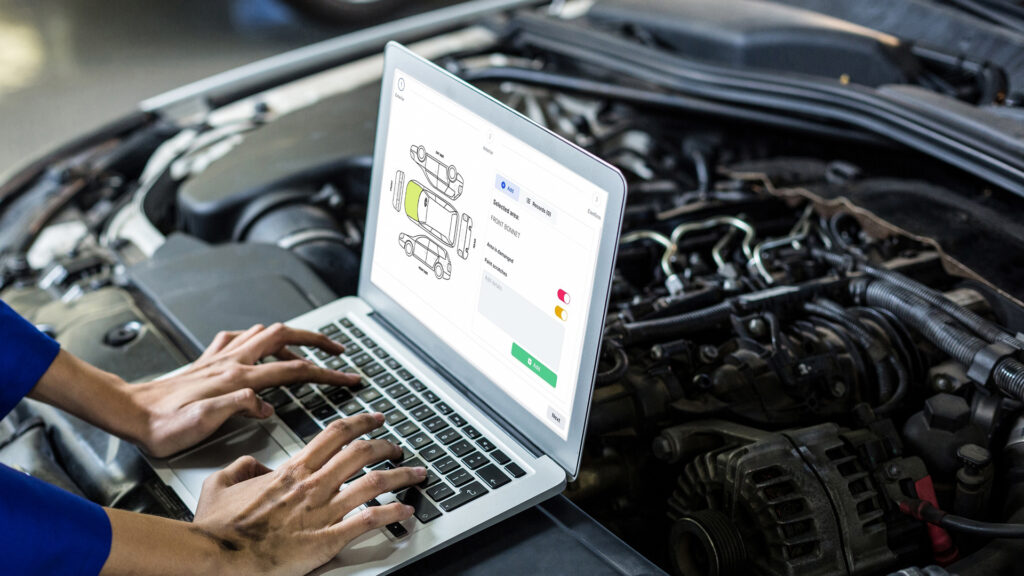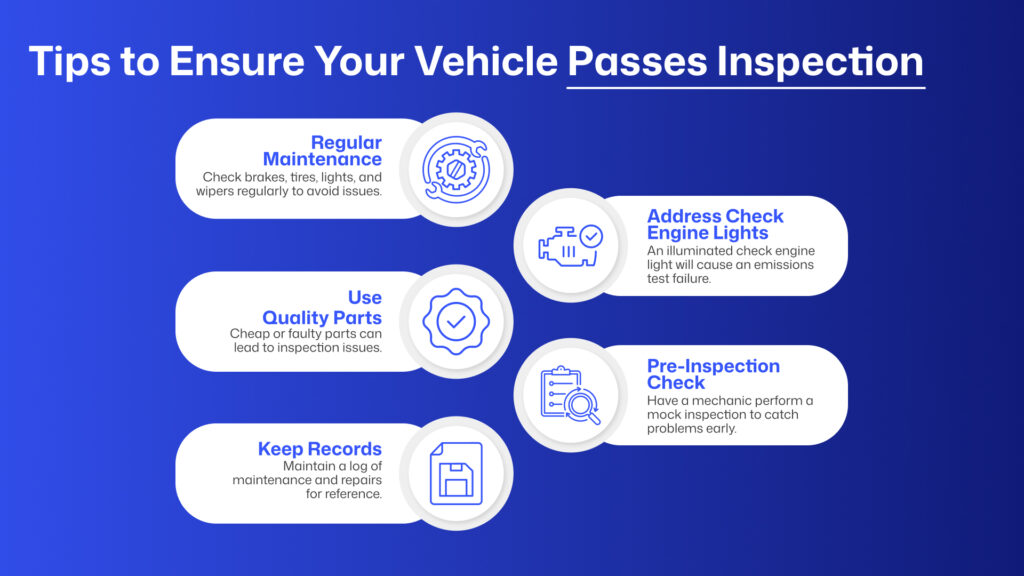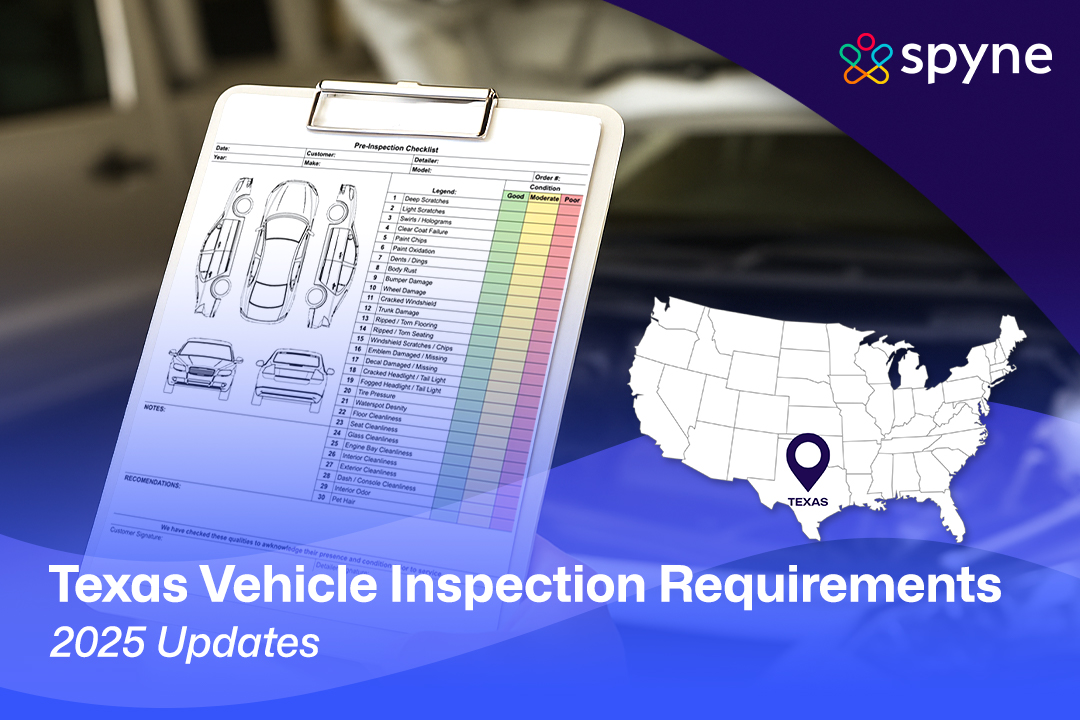As of 2025, Texas car inspection law has undergone a major overhaul. It has created both excitement and concern among drivers. The elimination of mandatory safety inspections for non-commercial vehicles has simplified the registration process for millions, but it comes with new responsibilities and nuances.
This blog explains the updated Texas vehicle inspection requirements for 2025, exploring what’s changed, what remains, and how you can stay compliant while keeping your vehicle safe.
Texas Vehicle Inspection Requirements (Until 2025)
Up until January 1, 2025, Texas vehicle inspection requirements mandated that all registered vehicles go through an annual safety inspection to meet the state safety standards. These inspections are a part of the Texas Vehicle Safety Inspection Program. They were designed to keep roads safe by checking components like brakes, tires, and lights.
But, House Bill 3297, signed into Texas car inspection law by Governor Greg Abbott in 2023, has changed everything. As of 2025, non-commercial vehicles are no longer required to undergo safety inspections before registration, a shift that affects millions of drivers across the state.
Despite this change, Texas vehicle inspection requirements still include a financial component. All non-commercial vehicles must now pay a $7.50 inspection program replacement fee during registration with the Texas Department of Motor Vehicles (TxDMV).
For new vehicles, those of the current or preceding model year that haven’t been registered in Texas or another state, the fee is $16.75, covering two years. This fee replaces the revenue previously generated by safety inspections, funding state programs like highway construction.
Elimination of safety inspections is celebrated for saving time and money. But, it has also raised concerns about road safety. Without mandatory checks accidents might increase.
Texas Vehicle Inspection Requirements by Vehicle Type

Texas vehicle inspection requirements depend on the type of vehicle you own. Non-commercial vehicles, such as personal cars, SUVs, and light trucks, are now exempt from safety inspections but must still pay the inspection program replacement fee. Commercial vehicles, including taxis, buses, and heavy-duty trucks must continue to undergo annual safety inspections to meet Texas safety inspection requirements. Because commercial vehicles still require these inspections, they are exempt from the replacement fee.
Some vehicles are also subject to additional rules. Motorcycles and diesel-powered vehicles are exempt from emissions testing but, until 2025, were required to pass safety inspections. Classic vehicles may also have specific exemptions, depending on their registration status.
What Is Tested at a Texas State Vehicle Inspection?
Although safety inspections are no longer required for non-commercial vehicles, it’s worth understanding what the Texas vehicle safety inspection process entailed to appreciate the shift in responsibility. The Texas vehicle inspection checklist included a thorough evaluation of safety components. Here’s what was checked:
Texas Safety Inspection Checklist

- Brakes: Ensuring proper function and no excessive wear.
- Tires: Checking for proper tread depth and no visible damage.
- Lights: Verifying that headlights, taillights, brake lights, and turn signals work.
- Windshield Wipers: Confirming they operate properly without streaking.
- Horn: Ensuring it’s functional and audible.
- Mirrors: Checking for proper adjustment and no cracks.
- Seat Belts: Verifying they latch securely and show no fraying.
- Steering and Suspension: Ensuring proper alignment and no excessive play.
- Exhaust System: Checking for leaks or excessive noise (for safety inspections, not emissions).
This Texas safety inspection checklist was designed for car damage assessment to catch issues that could compromise safety. Now, with these inspections eliminated for non-commercial vehicles, drivers should take it upon themselves so that their vehicles meet these standards.
Which Counties in Texas Require and Which Counties Do Not Require Emissions Testing?
While Texas vehicle inspection requirements no longer include safety inspections for non-commercial vehicles, emissions testing is still mandatory in certain counties to comply with federal air quality standards. As of 2025, 17 counties require emissions tests, with Bexar County joining the list in 2026. These counties are urban areas with higher pollution levels:
- Counties Requiring Emissions Testing: Brazoria, Fort Bend, Galveston, Harris, Montgomery, Collin, Dallas, Denton, Ellis, Johnson, Kaufman, Parker, Rockwall, Tarrant, Travis, Williamson, and El Paso.
- Counties Not Requiring Emissions Testing: All other Texas counties, including rural areas like Lubbock, Midland, and Amarillo, do not require emissions tests.
The cost of emissions tests varies by county and vehicle type, ranging from $11.50 to $25.50. Vehicles exempt from emissions testing include electric vehicles, motorcycles, diesel-powered vehicles, and those newer than two years or older than 24 years.
How Often Does My Vehicle Need to Be Inspected?
For non-commercial vehicles, the question of inspection frequency is now straightforward. Safety inspections are no longer required as of 2025. But, if you live in one of the 17 emissions-testing counties, your vehicle must undergo an emissions test annually before registration. Commercial vehicles, on the other hand, still have to go through an annual Texas state inspection requirement for safety.
How Will I Be Notified My Inspection Is Due?
Texas does not send notifications to remind drivers of inspection due dates. For emissions tests, the due date aligns with your vehicle registration expiration, which is printed on your registration sticker.
It’s your responsibility to track this date, as the TxDMV does not issue reminders. For commercial vehicles, safety inspections follow the same schedule, tied to registration renewal. You need to stay proactive.
Where Do I Get My Vehicle Inspected in Texas?
If you’re in an emissions-testing county or own a commercial vehicle, you’ll need to visit a Texas Department of Public Safety (DPS) approved inspection station. These stations are found at auto repair shops, oil change centers, or dedicated inspection facilities.
Since safety inspections for non-commercial vehicles are no longer required, the number of safety-only inspection stations has decreased, as DPS stopped issuing new licenses for these stations in July 2024. You can find a list of approved stations on the DPS website or by contacting your local TxDMV office.
What Is Texas Vehicle Inspection Cost?
The Texas vehicle inspection cost has shifted with the new law. Non-commercial vehicles no longer incur safety inspection fees, but you’ll pay a $7.50 inspection program replacement fee during registration.
New vehicles pay $16.75 for two years. Emissions test costs change by county, ranging from $11.50 to $25.50, depending on whether it’s an emissions-only test or includes safety components (for commercial vehicles). Commercial vehicle inspections cost between $7 and $25, depending on the vehicle type and location.
Documentation Needed for Vehicle Inspection
For emissions tests or commercial vehicle inspections, you’ll need to present specific documents at the inspection station. These include:
- Vehicle Registration: Proof of current or expired registration.
- Proof of Insurance: A valid insurance card or policy document.
- Photo ID: A driver’s license or other government-issued ID.
- Payment: Cash, card, or other accepted methods for the inspection fee.
The vehicle inspection for insurance purposes may also require similar documentation, especially if your insurer requests a car damage assessment to verify the vehicle’s condition.
What Is the Penalty for Driving With an Expired Vehicle Inspection Sticker in Texas?
Since Texas inspection stickers are no longer issued for non-commercial vehicles, the concept of an expired sticker applies only to commercial vehicles or emissions tests in designated counties.
Driving without a valid emissions test in these counties can result in a ticket for an improperly registered vehicle, with fines varying by jurisdiction but ranging from $100 to $200. For commercial vehicles, failing to have a current safety inspection leads to similar fines and potential impoundment. Also, driving with obvious safety defects, like broken lights or bald tires, can result in citations, as these violate Texas inspection law.
Tips to Ensure Your Vehicle Passes Inspection
Even without mandatory safety inspections, meeting the requirements to pass vehicle inspection in Texas is important for emissions tests or commercial vehicles. Here are some tips to ensure compliance:

- Regular Maintenance: Check brakes, tires, lights, and wipers regularly to avoid issues.
- Address Check Engine Lights: An illuminated check engine light will cause an emissions test failure.
- Use Quality Parts: Cheap or faulty parts can lead to inspection issues.
- Pre-Inspection Check: Have a mechanic perform a mock inspection to catch problems early.
- Keep Records: Maintain a log of maintenance and repairs for reference.
This Texas vehicle inspection checklist will help keep your vehicle roadworthy and help you meet the requirements.
Steps for New Texas Residents
New Texas residents must register their vehicles within 30 days of moving to the state. As part of this process, you’ll need to comply with Texas car inspection requirements. If you’re in an emissions-testing county, your vehicle must pass an emissions test before registration, regardless of a valid out-of-state inspection.
You’ll also need to pay the $7.50 inspection program replacement fee (or $16.75 for new vehicles). Bring your out-of-state title, proof of insurance, and photo ID to the TxDMV. This ensures that your vehicle meets Texas inspection requirements for emissions if applicable.
How Can Spyne Help?
Spyne offers innovative vehicle inspection solutions that can streamline the process for both drivers and businesses. With advanced AI-powered tools, Spyne provides accurate car damage detection, helping you identify issues like worn tires or faulty lights before they become problems.
For those in emissions-testing counties or with commercial vehicles, Spyne technology can assist with pre-inspection checks ensuring your vehicle meets Texas state inspection requirements. Dealerships and inspection stations can also utilise Spyne to enhance efficiency, providing detailed reports that improve customer trust and compliance.
Conclusion
The 2025 changes to Texas vehicle inspection requirements mark a significant shift, eliminating safety inspections for non-commercial vehicles. This also maintains emissions tests in urban counties.
While this saves time and money, it places the onus on drivers to keep their vehicles safe. Understanding the new Texas inspection law, staying proactive with maintenance, and using tools like Spyne for vehicle inspection can help you navigate these changes confidently. Stay informed, keep your vehicle in top shape, and drive safely on Texas roads.
















